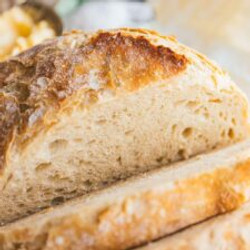
In a large mixing bowl, stir together the flour, salt, and yeast until well combined. Add the warm water and stir with a wooden spoon or spatula until the dough is uniformly mixed. The dough will be loose and shaggy, which is exactly how it should look.
Cover the bowl with plastic wrap or beeswax wrap, and let the dough rest at room temperature for 12 to 18 hours. The dough should rise and develop a slightly bubbly, wet surface.
After the rise, transfer the dough to a very well-floured surface. Flour your hands as well. Fold the dough onto itself by pulling the outer edges toward the center around the dough a few times until it tightens and forms a ball. If the dough feels sticky or loose, sprinkle more flour as needed. Lightly flour the top of the dough ball, then carefully flip it upside-down onto a piece of parchment paper so that the smooth side is facing up. Use your hands to shape the dough into an even circle. Lightly flour the top again, place on a piece of parchment, and loosely cover the dough with plastic wrap or beeswax wrap while the oven heats.
Place a Dutch oven (with the lid on) inside your oven and preheat to 450°F. Allow the Dutch oven to heat for 20-30 minutes while the dough continues to rest. If the dough spreads out more than you’d like during this time, you can reshape it into a tighter ball just before baking.
Using oven mitts, carefully remove the Dutch oven from the oven—be cautious, as it will be extremely hot. Lift the dough ball by the edges of the parchment paper and gently place it into the Dutch oven. Cover with the lid and bake for 30 minutes. Then, remove the lid and bake for an additional 10-20 minutes until the crust reaches your desired level of golden-brown and crispiness. The bottom of the loaf will sound hollow when thumped.
Remove the Dutch oven from the oven and carefully transfer the bread to a wire cooling rack using the parchment paper. Allow the bread to cool for at least 1 hour before slicing and serving.